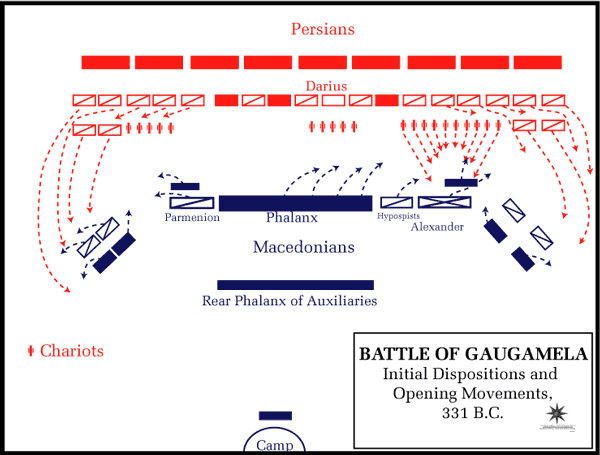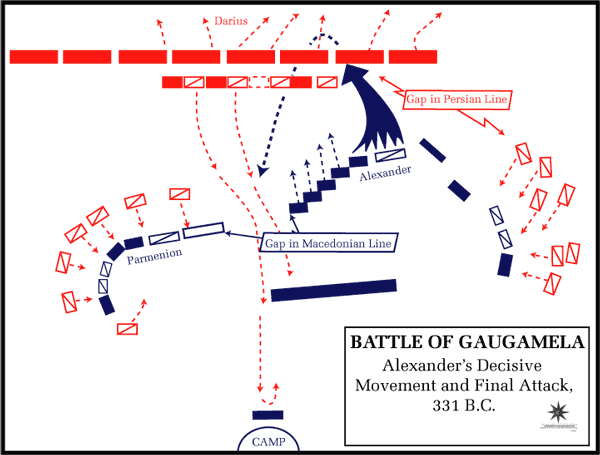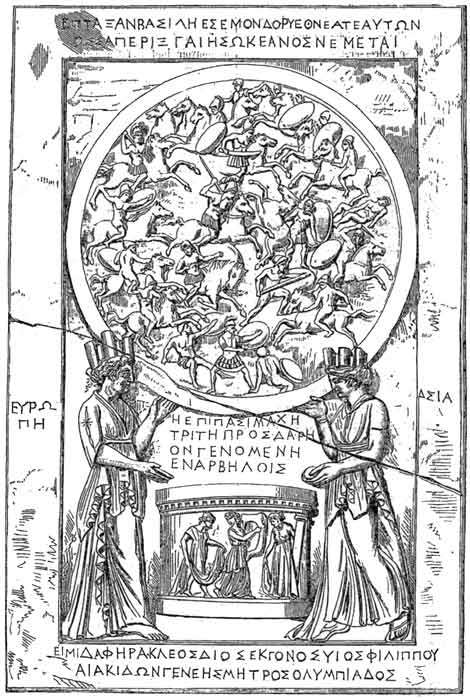.
In the Battle of Gaugamela in 331 BC Alexander the Great of Macedonia defeated Darius III of Persia. The battle is also inaccurately called the Battle of Arbela.
Combatants
Macedonians and Greeks under Alexander, 7,000 cavalry and 40,000 infantry. (According to Arrian)
Persians under Darius, with maybe 40,000 cavalry, 200,000 infantry and 6,000 Greek mercenaries. (Arrian gives an exaggerated number of 1,000,000 infantry.) The actual Persian numbers are unknown, although it is fairly clear that they substantially outnumbered the Hellenic forces.
Location
Darius chose (or smoothed out, depending on accounts) a flat plain where he could deploy his numerically superior cavalry forces. The location of the battle - near Tel Gomel, east of Mosul in northern modern-day Iraq - was determined by Sir Aurel Stein in 1938 (see his Limes Report, pp. 127-1. After the battle, Darius fled to Arbela (modern-day Arbil) 120 km to the east. The distance from Arbil to Mosul is roughly 80 km, so considerable room for discussion remains.
Prelude
During the two years after the Battle of Issus Alexander proceeded to occupy the Mediterranean coast and Egypt. He then advanced from Syria against the heart of the Persian empire. Alexander crossed both the Euphrates and the Tigris rivers without any opposition.
The battle


The battle began with the Persians already present at the battlefield.
Darius had recruited the finest cavalry from his satrapies and from an allied Scythian tribe. Darius also deployed scythed chariots for which he had prepared cleared terrain in front of his troops. He also had 50 Indian elephants supported by Indian chariots.
Before the battle, Darius ordered bushes and vegetation removed from the battlefield, to maximize the chariots' effectiveness.
Darius placed himself in the center with his best infantry (the Greek mercenaries and his guard infantry the "Apple Bearers"). On both flanks were the cavalry. Bessus commanded the left flank with the Bactrians and Scythians and Mazaeus commanded the right flank with the Syrian and Median cavalry.
Alexander commanded the Macedonian right flank himself, with the Companion cavalry and the Hypaspists, and Parmenio the left flank, with the Thessalian and Greek allied cavalry. Both flanks were protected by lightly armed troops, such as the Agrianians on the right. In the middle stood the Macedonian phalanx infantry in two lines, forming a "double phalanx". The second line was to turn around if out-flanked by the Persians.
The Macedonians advanced, as if entering the trap laid before them. Suddenly the whole army changed direction and started to move to the right, taking them away from the prepared ground. Darius now launched his chariots, some of which were intercepted by the Agrianians.
Darius ordered his left wing cavalry to encircle the Macedonian right and stop their rightward movement. This was countered by Alexander's Greek mercenary cavalry. As more Persian cavalry tried to encircle the Macedonian right flank, Alexander committed his last cavalry reserves to charge the point where the main Persian line joined the flanking cavalry. This caused a gap in the Persian line. Alexander turned his line and charged this gap with a wedge consisting of the Companion cavalry and the Hypaspists. The pursuing Persian cavalry was pinned down by peltists hidden behind Alexander's cavalry. It then advanced directly at Darius himself.
Darius now saw his left flank crumbling and the Macedonians advancing, in order to kill or capture him. He turned around his chariot and fled from the battlefield. The cavalry on the left followed him in his flight.
Aftermath
|
Battle of Gaugamela |
||
|---|---|---|
|
Conflict |
Wars of Alexander the Great |
|
|
Date |
1 October 331 BC |
|
|
Place |
Probably Tel Gomel (Gaugamela) near Mosul |
|
|
Result |
Macedonian victory |
|
|
Combatants |
||
|
Macedon |
Persia |
|
|
Commanders |
||
|
Alexander the Great |
Darius III |
|
|
Strength |
||
|
7,000 cavalry |
40,000 cavalry |
|
|
Casualties |
||
|
At least 500 killed and wounded |
About 40,000 killed and wounded |
|
The Persians lost maybe 40,695 men. Darius fled with his guard and some Bactrian cavalry. Alexander pursued him all the way to Arbil about 120 km from the battlefield. Darius managed to escape to Media, but was later killed by Bessus.
Later Alexander was crowned "King of Asia" in a magnificent ceremony in Arbela.

Alexander at the altar fire on the eve of the battle of Gaugamela by Andre Castaigne

Gaugamela (Arbela) Relief, Chigi Palace Rome, with Personification of Europe and Asia
"I am a relative of Heracles and Zeus, son of Philip and Olympias"
| Ancient Greece
Science, Technology , Medicine , Warfare, , Biographies , Life , Cities/Places/Maps , Arts , Literature , Philosophy ,Olympics, Mythology , History , Images Medieval Greece / Byzantine Empire Science, Technology, Arts, , Warfare , Literature, Biographies, Icons, History Modern Greece Cities, Islands, Regions, Fauna/Flora ,Biographies , History , Warfare, Science/Technology, Literature, Music , Arts , Film/Actors , Sport , Fashion --- |
Retrieved from "http://en.wikipedia.org"
All text is available under the terms of the GNU Free Documentation License

